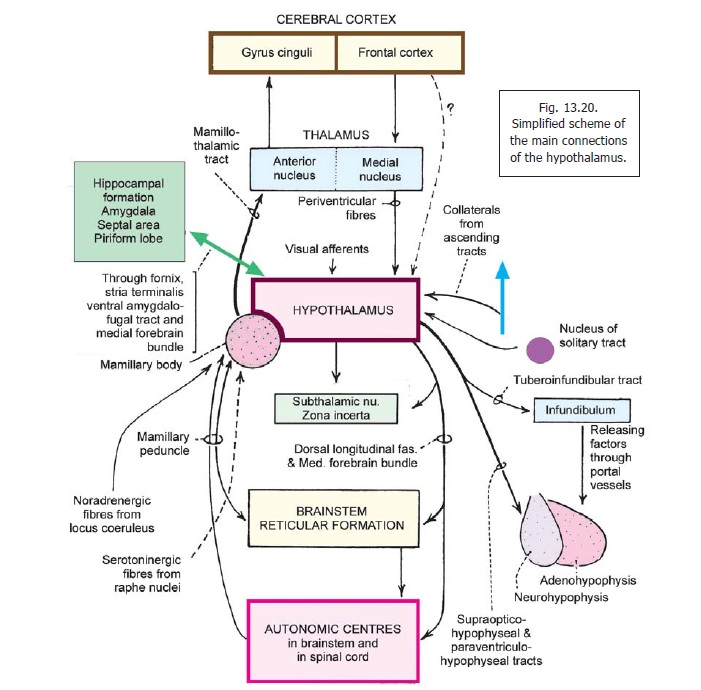Chapter: Human Neuroanatomy(Fundamental and Clinical): The Diencephalon
Connections of the Hypothalamus
Connections of the Hypothalamus
The hypothalamus is concerned with visceral function and is, therefore, connected to other areas having a similar function. These include the various parts of the limbic system, the reticular formation, and autonomic centres in the brainstem and spinal cord (Figs. 13.19, 13.20). Apart from its neural connections, the hypothalamus also acts by releasing secretions into the blood stream, and into CSF.


Afferent Connections
1. The hypothalamus receives visceralafferents (including those of taste) through the spinal cord and brainstem. The exact pathways are not known. They probably pass through the reticular formation and consist of several relays.
Many of these fibres pass through a bundle called the mamillary peduncle. Other fibres pass through a bundle called the dorsal longitudinal fasciculus. Fibres from the tegmentum of the midbrain also reach the hypothalamus through the medial forebrain bundle.
2. Afferents from the nucleus of the solitary tract carry taste impulses (and other visceral sensations).
3. Somatic afferents reach the hypothalamus through collaterals of major ascending tracts.
4. The hypothalamus receives afferents from several centres connected to olfactory pathways, and to the limbic system.
These are the anterior perforated substance, the septal nuclei, the amygdaloid complex, the hippocampus and the piriform cortex. Many of these fibres reach the hypothalamus through the medial forebrain bundle. Fibres from the hippocampus travel through the fornix. Some fibres from the amygdaloid complex pass through the stria terminalis, and some through the ventral amygdofugal tract (Fig. 16.9).

Olfactory impulses are received after relay in the nucleus accumbens (in the ventral thalamus, near the anterior perforated substance); and through septal nuclei.
Visceral impulses reach the suprachiasmatic nucleus.
The locus coeruleus is connected to the hypothalamus through diffuse noradrenergic fibres. The raphe nuclei project to the hypothalamus through serotoninergic fibres. Some cholinergic and dopaminergic fibres also reach the hypothalamus.
5. Cortico-hypothalamic fibres: In addition to fibres from the piriform cortex (mentionedabove) the hypothalamus is believed to receive fibres from the cortex of the frontal lobe. Some of these are direct. Others relay in the thalamus (medial dorsal and midline nuclei) and reach the hypothalamus through periventricular fibres (so called because they travel just subjacent to the ependyma). The gyrus cinguli may influence the hypothalamus indirectly through the hippocampal formation. Some fibres from the orbital cortex may reach the hypothalamus through the medial forebrain bundle.
6. The hypothalamus also receives fibres from the subthalamic nucleus, and the zona incerta.
Efferent Connections
1. The hypothalamus sends fibres to autonomic centres in the brainstem and spinal cord. Centres in the brainstem receiving such fibres include the nucleus of the solitary tract, the dorsal nucleus of the vagus, the nucleus ambiguus, and the parabrachial nucleus. Fibres descending to the spinal cord end in neurons in the intermediolateral grey column. It also sends fibres to the hippocampal formation, the septal nuclei, the amygdaloid complex, and the tegmentum of the midbrain, and autonomic centres in the brainstem and spinal cord. These fibres pass through the same bundles that convey afferent fibres from these centres.
2. Fibres from the mamillary body pass through the mamillothalamic tract to reach the anterior nucleus of the thalamus. New fibres arising here project to the gyrus cinguli. Fibres from the mamillary nuclei also reach the subthalamic region and the tegmentum. (through the mamillo-tegmental tract).
3. Fibres from the hypothalamus project widelyto the neocortex. They play a role in maintaining cortical arousal.
Related Topics